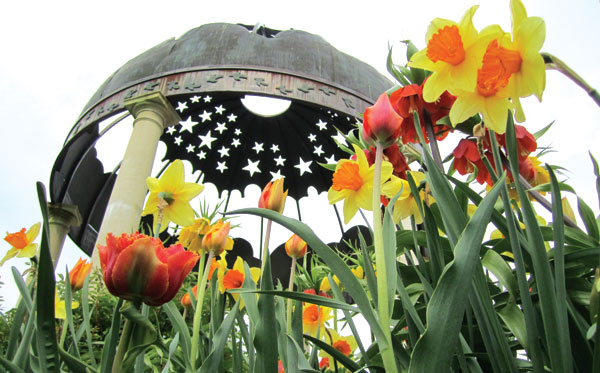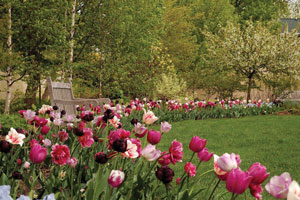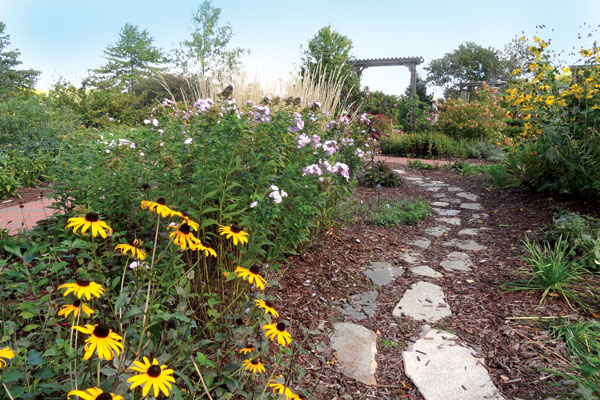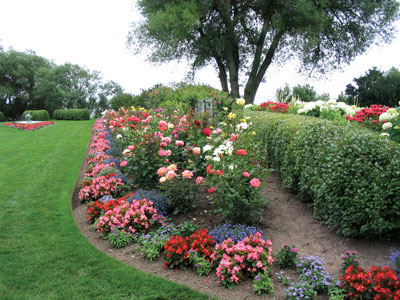In Bloom
The first sprouts of green emerging from the ground are a sought-after sign that warmer days are soon ahead. Whether you have a green thumb or are an admirer of the many varieties of petals that exist, area gardens look forward to visitors searching for colorful inspiration, relaxed enjoyment and a bit of fresh air. From Green Bay to Oshkosh to Appleton and Manitowoc, FOX CITIES Magazine discovered four unique spaces that are just a car ride away.
Green Bay Botanical Garden
“A lot of people know us from our (WPS) Garden of Lights,” says Mark Konlock, director of horticulture at the Green Bay Botanical Garden. While the annual holiday event, entering its 19th year in 2015, includes a quarter of million bulbs — twinkling lights, that is — the gardens themselves include 130,000 bulbs between the 80,000 perennials and the additional 50,000 that are planted each year.
“It’s a lot to see, especially for the home gardener,” Konlock shares. “Our bulbs are timed to bloom around Mother’s Day.”
Konlock believes visitors and yet-to-be visitors don’t realize the extent of the garden.
“It’s really a beautiful place, it’s a tranquil place, it’s a chance to recharge,” he explains. “I don’t think people realize how much is out there. … We really encourage people to come out in general, but really in spring because of the bulb display.”
In May, tulips, daffodils, crab apple trees and magnolias — of which the garden includes 125 different kinds — are at their peek, along with the bulb display. Peonies, perennials, hostas and foliage arrive in June with the perennials, and the annual beds make their appearance in July. Bulbs are removed as they fade, Konlock says.
“A lot of people who walk here say it looks different every day,” he adds. “It definitely changes throughout the season in color and variety. … We have things planned to bloom all year.”
“We’ve been really increasing our collaboration and developing our gardens in the last few years,” notes Konlock, adding local garden groups and students from Northeast Wisconsin Technical College volunteer their time to help maintain the spaces.
Popular gardens within the Green Bay Botanical Garden are the Kress Oval Garden, a noted wedding site adorned with a contemporary rose garden; the Gertrude B. Nielsen Children’s Garden with its treehouse, slide, vine maze, giant sundial and a recirculating pond; and the King Shade Garden, which showcases plants that grow in the shade, along with a water feature.
“There are so many things going on here,” Konlock notes. The Green Bay Botanical Garden hosted 90 weddings last year alone.
To learn more about admission rates, hours and events, visit gbbg.org.
Paine Art Center and Gardens
At a little over three acres in size, the Paine Art Center and Gardens in Oshkosh features 17 themed gardens including the Shade, Rose, Herb and Contemporary gardens on the grounds of the historic estate, which opened to the public for enjoyment and education in 1948. The Reception and Rose gardens will receive new design elements this year, says Sheila Glaskey, curator of horticulture.
Much like the mansion itself, the garden spaces were designed as “rooms” to showcase a variety of plants and each have their own traffic flow with defined pathways. The gardens include perennials, trees, shrubs and wildflowers. The overall look of the gardens changes annually. More than 400 varieties of annuals are planted each year.
“We’re doing the gardens this year in an English style,” Glaskey describes. “I call it a beautiful mess because there’s a lot of color, but not a specific pattern.”
Visitors also will find approximately 70 containers filled with annuals and some tropicals.
“The containers pull out the colors in the gardens,” Glaskey says. “I think most people are surprised at the amount of vegetables that are planted in the garden, too.”
Eggplant, leeks, cabbage, parsley, sage, kale and other herbs also have made appearances in the gardens. Vegetables are donated to the food pantry in Oshkosh.
In mid-May, visitors can anticipate seeing 7,000 tulips in bloom. This month also brings the Mother’s Brunch on May 9 and Festival of Spring on May 16, which is a free outdoor fair that will have approximately 5,000 plants for sale in the front of the Paine and more than 100 vendors of original art, fine crafts, plants and garden supplies.
“We do have a lot of people come in after people see them (the flowers) in the front,” Glaskey says. “I think people are always surprised that we do have the gardens because we are walled off.” The Paine is the only “walled” garden in Wisconsin, Glaskey adds.
In addition to mid-May, the end of June and beginning of July, along with October are peak times to visit the gardens.
“When Nathan and Jessie Kimberly Paine began planning their home in the mid-1920s, they envisioned more than a house, but an elaborate setting in the style of an English country estate,” according to thepaine.org.
When the property became public, it was first called the Paine Art Center and Arboretum due to the trees, shrubs and vines on the property. Over time, the original design deteriorated as damaged and diseased trees needed to be removed and the grounds evolved.
“I think the garden spaces are a place where people can bring their lunch and make a day of it,” Glaskey says, adding that there are benches and tables available onsite.
For more information on admission rates, hours and events, visit thepaine.org.
Scheig Center at Memorial Park Gardens
More than 30 acres of land make up the Scheig Center at Memorial Park Gardens in Appleton. The tucked away space, located at Memorial Park, includes beds of perennial flowers. A volunteer group now assists the Appleton Parks and Recreation Department Parks, Recreation & Facilities Management Parks Grounds Crew in maintaining the gardens.
“The City of Appleton will team with community representatives including, but not limited to, the Master Gardeners, Wild Ones and Fox Valley Technical College to develop a collaborative effort to maintain and provide opportunities for the public and students to share their passion and interests, including those pursuing careers in horticulture and related fields,” says Dean Gazza, Parks, Recreation Facilities Management director.
The APRD took over operation of the gardens in March 2014. The space was established in 2003. “The Scheig Center will be utilized by the community including individuals, nonprofit groups, corporations and the City of Appleton’s own recreation department to educate, celebrate and to provide recreational opportunities. This facility will be available for rental by the public year around,” explains Gazza.
“It’s a passive space that people can visit during regular park hours,” adds Heidi Erickson, recreation programmer, of the free opportunity. Erickson notes there is a map located outside of the Scheig Center for self-guided tour purposes. No formal tours are available at this time.
While the peak times of year vary for this particular garden space, some perennials are visible beginning in early spring. However, the majority peak from summer into fall. In early spring, tulips, daffodils and red crown imperial lilies emerge, while spring into summer gives way to purple coneflower, gray headed coneflower, spiderwort, butterfly milkweed, black-eyed Susan and Asiatic lilies. The best time to catch the rose gardens, shrub roses, rattlesnake master, hibiscus, hydrangea, day lilies, shasta daisies, butterfly bush, Joe-pye weed and ornamental grasses is summer into fall.
“The gardens offer a picturesque opportunity for all to view,” says Erickson. “Wildlife is abundant in the gardens from singing frogs to butterflies! You will not be disappointed with the beauty the gardens provide.”
When the gardens were first conceived, many smaller garden spaces made up the garden as a whole, Erickson notes. “Some of the gardens visitors may view are: Four Seasons Garden & Veteran Dry Stream Memorial, Bird Meadow, Meadow Garden, Prairie, Wet Meadow Garden, Winter Garden, Serenity Garden, Rose, Herb & Fragrance Gardens and Wildflower Woods,” says Erickson.
“These gardens will be limited to a variety of native and non-native plantings. The gardens are not intended to be expanded and will be limited as display gardens,” adds Gazza.
In addition to the gardens, Memorial Park offers walking trails, a pond and universal playground. A master plan for the park is in the works for the future to best determine how currently non-programmed spaces can be utilized to benefit the park.
Visit appletonparkandrec.org/parks,-pavilions-and-trails/scheig-center for further information.
West of the Lake Gardens
Off of Memorial Drive in Manitowoc, a secret garden of sorts lies. Once a private residence, the 61⁄2 acres are now open to the public and continue to be owned and operated by the Ruth St. John and John Dunham West Foundation, Inc. as the West of the Lake Gardens. There are no walking trails on the property, but lawns are open for walking free of charge seven days a week from 10 a.m. to 5 p.m. during its open season. An informational kiosk is available with self-guided tour maps and larger groups are invited to call ahead to arrange tours.
The gardens are expected to open May 16 this year. Due to the effects of the property being situated right off the shores of Lake Michigan, the date varies a bit from year to year. West of the Lake Gardens is expected to remain open for the season until the first frost hits around mid-October, says Don Cisler, head gardener and horticulturist.
May visitors can anticipate daffodils, hyacinths and tulips, while perennials will be green and growing as well at that time. The day after Memorial Day, Cisler and his crew are expected to plant 18,000 annuals.
“Because we’re right on the lake, we’re held up a bit,” Cisler notes. “By the third week of June, the first flush of bloom will be showing.” Mid- to late-July, the second flush happens when the annuals settle and the perennials begin to bloom, Cisler adds. The West of the Lake Gardens is a showcase of 160 hybrid tea roses and includes 10 garden spaces, in addition to potted and hanging plants.
“I try to change it up a little bit each year, but we try to stay true to what Ruth West was doing,” Cisler explains. “I change up the supporting cast each year. I know what my bread and butter are.”
The garden started in April 1934 when Ruth, who passed in 1990 following her husband’s death in 1989, and her gardener hand spaded the property to remove weeds and establish the lawns. The West home was built the same year and echoed the designs of Walter Gropius and Frank Lloyd Wright. The garden began with 200 tulips and by the 1950s, more than 30,000 filled the gardens leading to the property being opened to the public for the annual West of the Lake Tulip Teas, according to the westfoundation.us. As the tulips faded, they were replaced with plantings of geraniums and begonias, the site states. By 1967, all remaining tulips were removed and the gardens saw a strong eastern influence during the 1970s and ’80s with the addition of a Japanese Garden the history concludes.
New to the gardens this year, Cisler plans to add SunPatiens, a type of impatiens that take the heat and sun well. He has planted some in the The Red and White Garden previously, but will be expanding into orange and violet options as well. New types of geraniums and begonias also will make an appearance.
A grower germinates seeds for the gardens, but they are then raised onsite from flood stages in the gardens’ greenhouse, Cisler shares. Growing begins by mid-February, potting and cutting of mother plants also occur at West of the Lake.
“We try to keep this a low-maintenance garden, but at the same time, this is a very well-maintained garden,” Cisler says. “I think what sets us apart from other places is the formality of this place.” For example, everything is edged where the lawn ends and the gardens begin.
For more information, visit westfoundation.us.
—FC














Leave a Comment